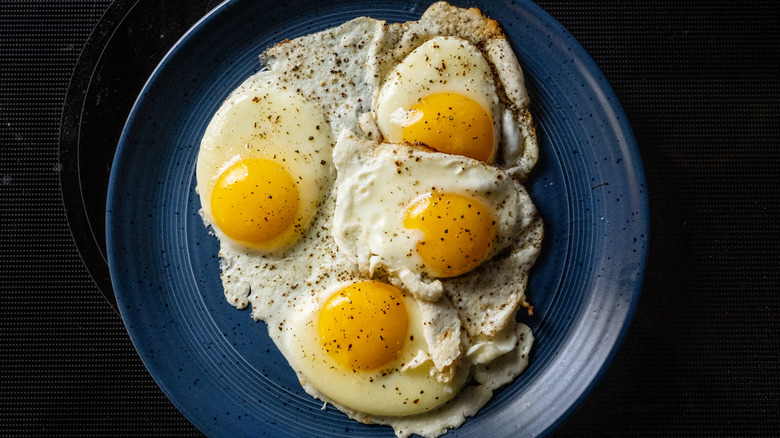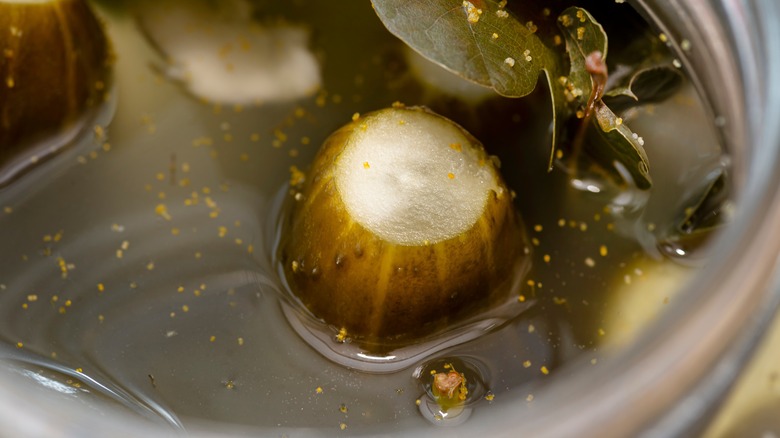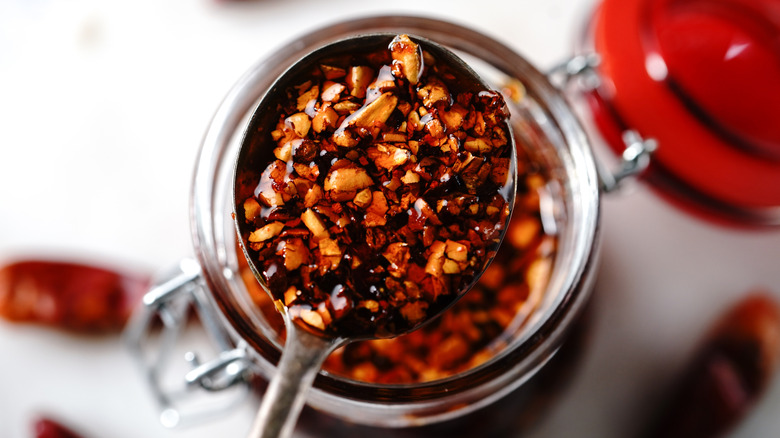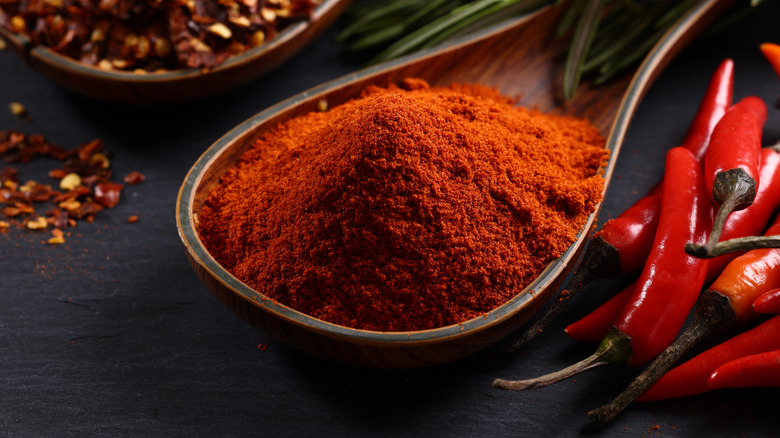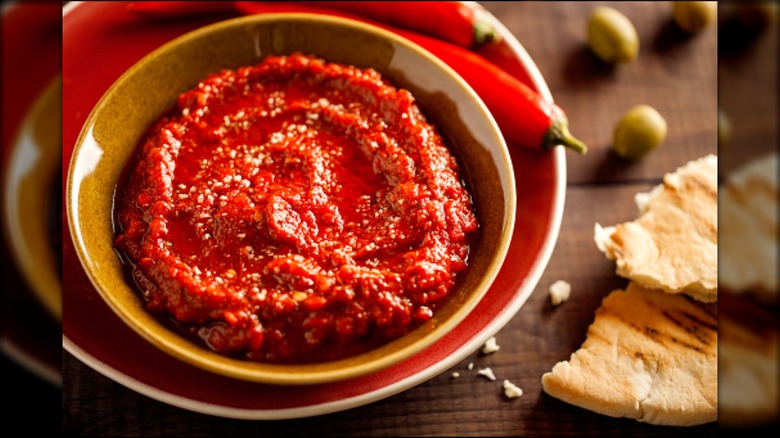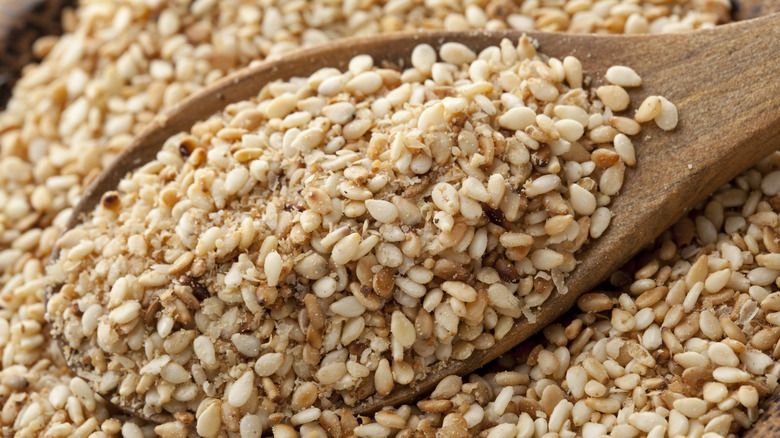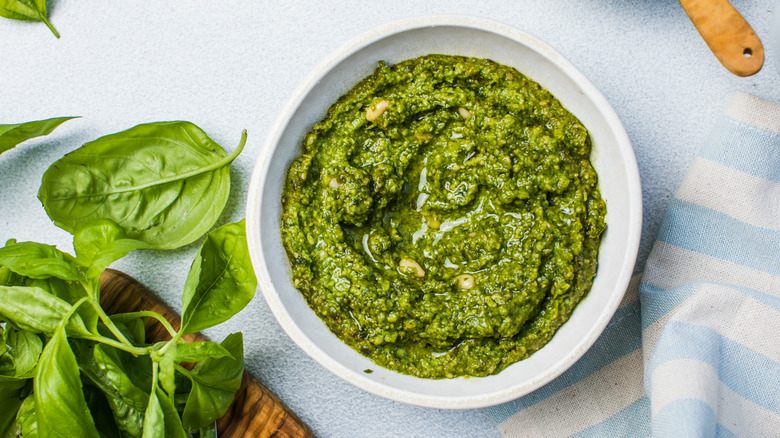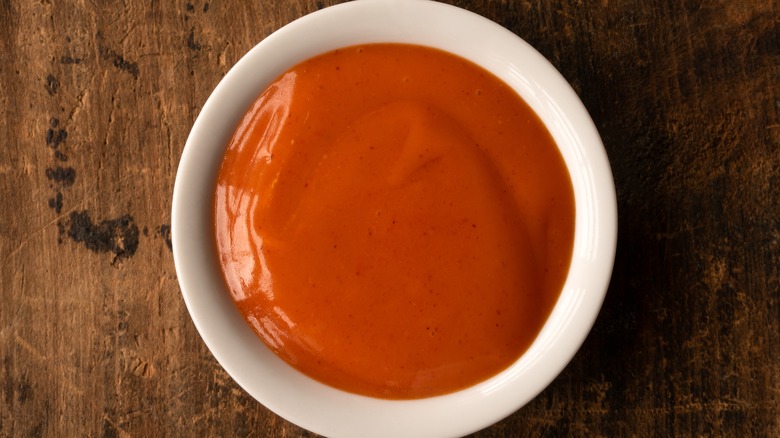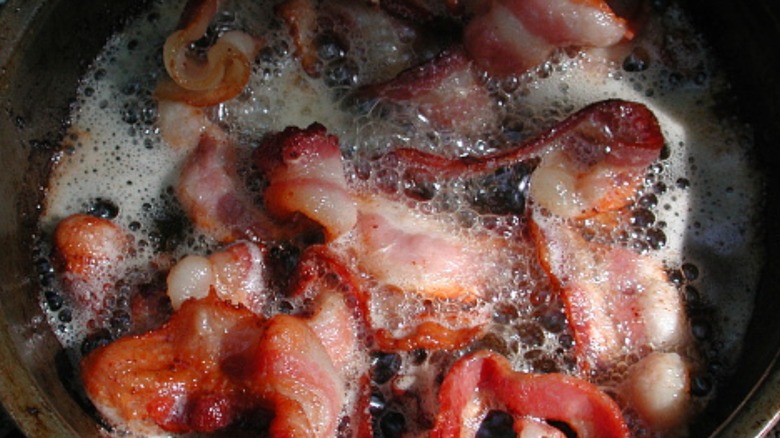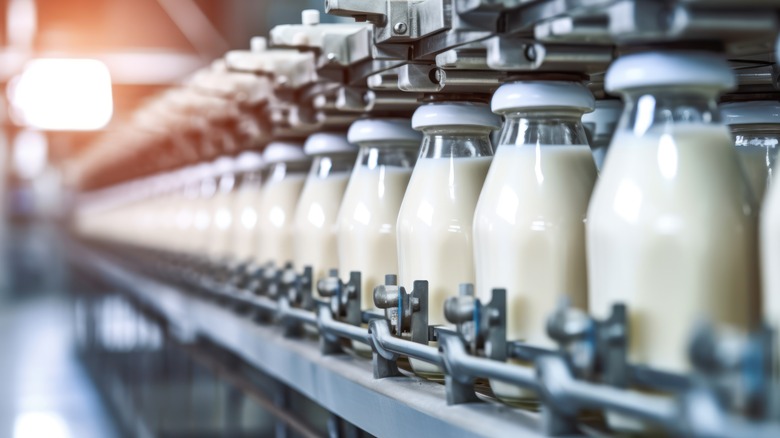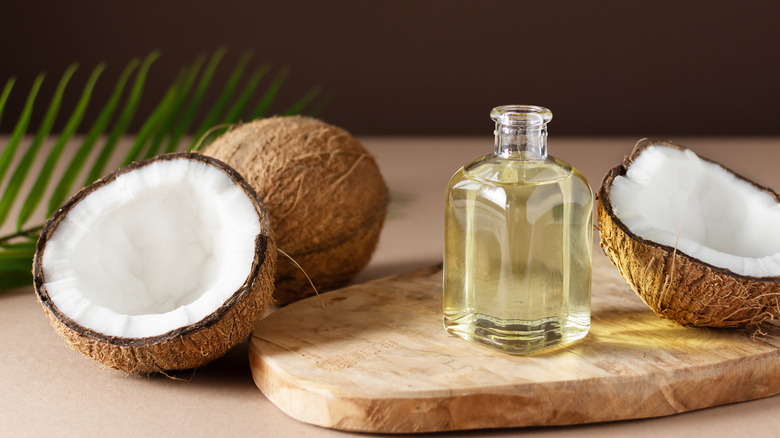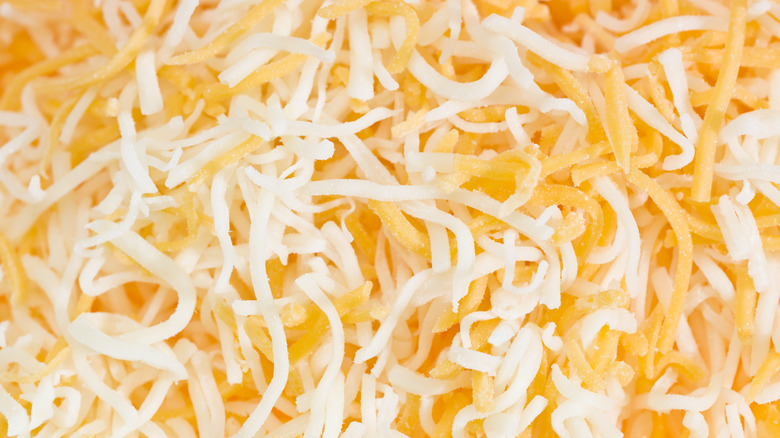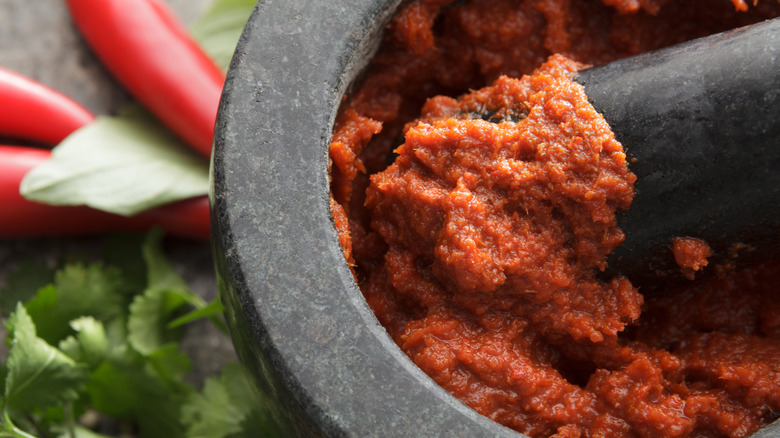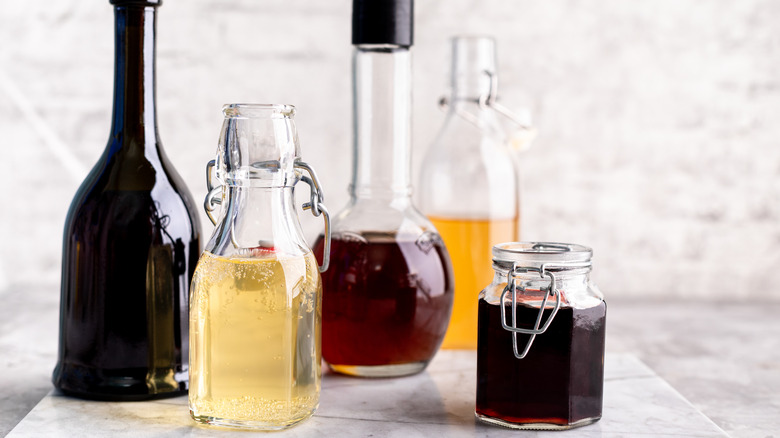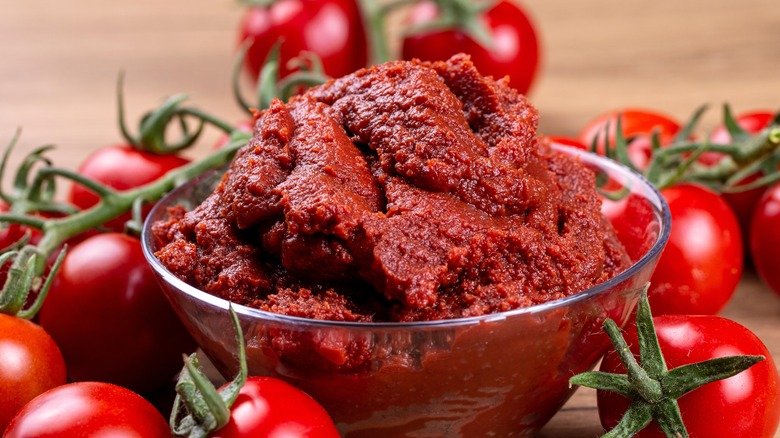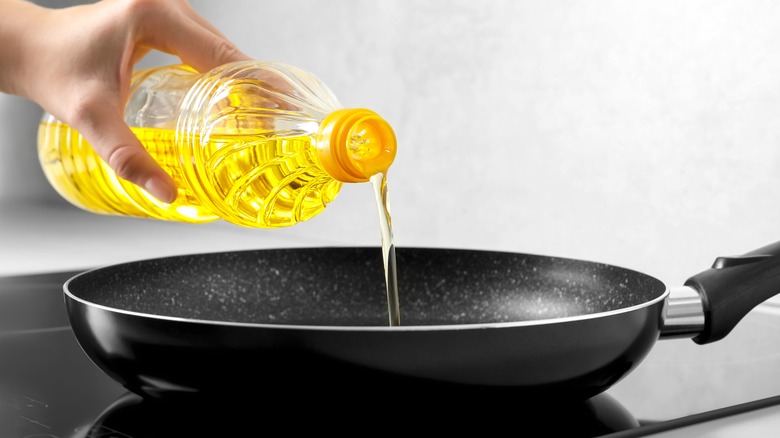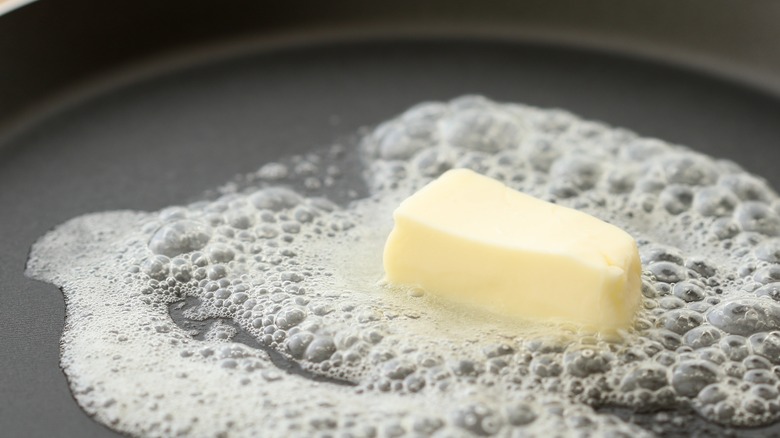16 Ingredients That Will Make Your Fried Eggs Unbeatable
Crack your egg into the pan, let it sizzle, watch until the perfect time, and then give it a flip. Let it cook a little longer until you reach your desired level of doneness and — voilá — you have a fried egg.
A fried egg is a fried egg is a fried egg ... right? Well, not really. While fried eggs are delicious, don't make the mistake of thinking this simple breakfast staple (or anytime food — who doesn't love a fried egg on their burger?) is without room for improvement. You can level up your fried eggs with just a few ingredients that you likely already have in your pantry.
Some of these ingredients act as the perfect cooking fat or liquid to replace your typical oil or butter, while others fuse to your fried egg to create a one-of-a-kind concoction that's equal parts surprising and delightful. Each one, however, is sure to make your fried eggs unbeatable. Here are our top recommended ingredients, and how to use them.
Pickle juice
Don't knock it 'til you try it. If you love all things pickle-flavored, or you're never one to hesitate to use that leftover pickle juice in the bottom of the jar for a salad dressing or marinade, you'll want to use this trick. It's offered up by content creator Dan Clapson. In a TikTok video, he shows how you can simply add a bit of pickle juice, straight from the jar, to your almost-done fried eggs. Simply pour over the top as a finishing flourish and let the juice reduce off.
The result is a ton of extra flavor, and commenters have chimed in with explanations as for why this might be a good hack: Pickle-adjacent flavors are already favorites when paired with eggs, such as dill and fermented accents like those from kimchi. Don't add all your pickle juice to your fried eggs, though. You're going to need a little bit leftover to add to your Bloody Mary.
Chili crisp
Whether you call it chili crisp, chili oil, or chili sauce, the highly popular condiment is more or less always delicious. If you're unfamiliar, it's a mix of fried-until-crispy chili peppers and similarly flavorful ingredients infused in oil, along with some seasonings. You can make your own chili crisp easily at home, but you can also buy it in the store, thanks to the condiment's growing popularity.
Chili crisp is an excellent addition to your fried eggs for a few reasons. One, it adds a ton of flavor, especially if you prefer your eggs with a bit of a spicy kick. Two, since the chili crisp is oil-based it can take the place of whatever fat you might normally fry your eggs in. To use it, add the chili crisp to your pan and bring it to heat. We recommend using more of the oil and less of the "crisp" for this function. However, if you do get some bits and pieces in there, make sure to keep the heat at medium or below to ensure you don't burn the pieces. Once your spicy oil is hot, fry your eggs, and get ready for a big burst of flavor.
Paprika
If you've no chili crisp on hand, but you have a full spice rack, reach for some paprika. Made from ground, dried peppers, paprika lends extra flavor to your fried eggs. Especially if you opt for one of the more interesting varieties of paprika, versus just typical, milder plain paprika. A whole wide world of paprika varieties awaits. Go Hungarian for complex, sweet-leaning, deep flavors. Try Spanish for a smokier slant. Regional paprikas will use unique blends of pepper, ensuring a different profile across each spice.
In addition to sprinkling a little paprika over your fried eggs as you cook them, as you might salt or pepper, also add paprika to your cooking oil before you fry your eggs. This can enhance the flavors further and is very similar to how you might make an infused paprika oil, which is often seen in sauces, marinades, or as a garnish.
Harissa paste
Whether you make your harissa or buy it at the store, this paste is essentially chiles blended with garlic, oil, and spices. Sometimes, additional ingredients are added, like components that add a bit of acidity such as tomatoes or citrus juice. There's a bit of flexibility in what's used, and varying levels of spice, but harissa is always super-fragrant. The consistency is also on the thicker side (think tomato paste), so it's ideal for spreading — as well as adding to you fried eggs.
All you have to do is add your preferred amount of harissa (more paste means more flavor) to your skillet at the same time that you heat your oil. Then, add in your eggs and fry them like normal. The result is an extremely flavorful egg, with just a tinge of colorful red.
Sesame seeds
If you like sesame in any form, you might just like sesame seeds on your eggs. However, don't just go with plain ol' sesame seeds. Instead, use toasted sesame seeds, which offer a far nuttier flavor.
You can toast sesame seeds just like you might toast spices, in a pan over medium-heat for just a few brief minutes. However, if you're already frying some eggs, you can shorten the cooking process (and reduce the number of dishes you'll need to wash later) by toasting your sesame seeds first, and then frying your eggs in the same pan, in oil. For more varied flavors, try using different kinds of sesame seeds beyond the most common white variant. Black sesame seeds are more fragrant, while white sesame seeds sweeter. The former is also a slightly crunchier egg topping.
Pesto
For fried eggs with a little Italian flair, fry your eggs in pesto. This simple mixture of basil, olive oil, parmesan, and pine nuts offers unmistakable flavor, no matter if you're tossing your pasta in it or spreading it on a thick piece of crusty bread for a sandwich. Additionally, because it's oil based, it's a perfect option for frying your eggs, as all you have to do is add the pesto to your pan followed by your eggs.
This simple yet genius idea can be used for any types of eggs, not just fried. Still, using pesto for your fried eggs is as straightforward as swapping the pesto for cooking oil, and adding salt, pepper, and red pepper flakes. Additionally, you can paste the pesto on to the top of your fried eggs as well. Pesto-fried eggs go great as a topping for a scrumptious piece of buttered avocado toast.
Buffalo sauce
Who doesn't love buffalo sauce? Savory, tangy, and perfect on wings or in a dip, buffalo sauce pairs amazingly well with fried foods and cheese — and will, as such, be the perfect accompaniment to your fried eggs, especially if you also melt some cheese on top. Sandwiched between bread, it's also a great add to your fried egg on a cheesy breakfast sandwich.
You can, of course, drop a few sprinkle on your serving of buffalo sauce, just as you might top your fried egg with hot sauce, but consider actually cooking your eggs in the buffalo sauce as well. Add a few teaspoons of sauce to the pan per egg — you're trying to fry your egg, not poach it, after all — and then crack your egg onto the sauce. Cook like normal, flipping and allowing the egg to reach your desired done-ness.
Bacon fat
If you're not already using leftover bacon grease to fry your eggs, then where are you putting it all? Bacon fat is an amazing cooking fat and adds ample, porcini salinity. It just makes sense to use bacon fat to cook the rest of your breakfast.
You can, of course, just cook your bacon in your pan first and then cook your eggs in that residual bacon grease. However, you can also use pre-cooked and stored leftover grease. When stashing your bacon grease for later use over fried eggs, let the grease cool, strain it to remove any solids, and then store the bacon in a glass jar in the fridge. The grease will harden into a Crisco-like fat, which you can then scoop and use as needed.
If you crave a different kind of bacon texture in your fried eggs, consider use pieces of bacon meat while frying. You'll need pre-cooked bacon broken into small pieces for this technique. Crack your egg into the pan, and while the egg is still forming into a solid, drop small chunks of bacon into it. As the whites harden, your egg will become studded with bacon.
Cream
It's not uncommon to fry eggs in butter. Using cream then is a feasible way to fry an egg, and produces a luscious texture that you won't get any other way. This is an option for those who want a fried egg that's on the silky and soft side, rather than on the slightly-crispy-around-the-edges side.
For this method, you add heavy cream to a pan (again, not too much, because you don't want to end up poaching the eggs), and then you crack the eggs on top and let them cook until done. The result is very similar to shirred eggs, which are a type of eggs made by pouring cream into ramekins (or another baking dish), cracking the egg into the dish as well, and then baking the combination until done. Another consideration is careful and slow heat management, as you don't want to curdle the milk.
Coconut oil
Another oil alternative that you might not of thought of using in place of your standard butter, coconut oil has a high smoke point that allows you to fry your egg at a high heat, without worrying about the oil going smoky or burnt. If you're worried that coconut oil will make your egg taste like a coconut cake, don't. Instead, the imparted flavor is mild and only slightly sweet and nutty, so long as you use refined coconut rather than virgin coconut oil or unrefined coconut oil.
To fry your eggs, make sure the coconut oil has gone clear, otherwise you could crack your eggs over clumps of oil that don't spread or cook evenly. After that, it's a simple ingredient to add to your fried eggs as it's a one-for-one substitution with whatever other cooking fat you use. That said, don't try this option just because you think it'll make your breakfast healthier. Studies have found that coconut oil has a substantial amount of fat and calories.
Shredded cheese
If you take a handful of shredded cheese or grated cheese, like parmesan, and sprinkle it into a circle on a parchment paper-lined baking sheet, and pop it in the oven, within a few minutes, you'll get beautiful golden circles of crispy baked cheese, like a little snack cracker. The beauty of this process is that you can add an egg to it.
Adapt this method for your fried eggs by placing small mounds of shredded cheese in a large, non-stick skillet. As the cheese begins to melt, crack your eggs onto the cheese. Once the fried eggs are ready to flip, slide your spatula beneath the cheese and turn the eggs over. You'll find that the cheese and eggs have fused together without mixing, so now you have a fried egg with a lovely crunchy, all-cheese layer on the bottom.
Thai curry paste
Much like harissa, Thai curry paste is a condiment made from a finely blended mix of chiles, aromatics, and spices, along with the occasional "extra" ingredient based on the maker's whims, like dried shrimp or peanuts. And, like harissa, Thai curry paste has a spreadable consistency that makes it perfect for frying an egg.
To make a Thai curry fried egg, simmer a few tablespoons of coconut milk before mixing in Thai curry paste. Look for a smooth consistency, then crack the egg atop that mixture and allowing the curry to cook it. You don't want to cover the egg completely, and the temperature should be high enough that the edges of the egg firm up rather than spreading into the milk. If you want to get extra fancy, you can serve your Thai curry fried egg on toast with a sauce made from basil, coconut milk, and fish sauce.
Vinegar
While you might at first think that vinegar would not pair well with something as simple as a fried egg, consider that pickle juice works great as an ingredient for better fried eggs. As do vinegar-based condiments, like buffalo sauce. Thus, breaking out your favorite high-quality vinegar is a worthwhile decision for frying eggs. This is not the place for your basic bottle of white vinegar, as you want the liquid to impart something into the frying egg.
For this option, don't cook your eggs in the vinegar; instead, reduce the vinegar in a pan after your eggs are cooked, creating a sort of sauce in the remaining butter, and then pour that over your eggs. Not feeling like going through the extra step of making a sauce? You can simple drizzle wine vinegar on top of the eggs, after cooking. Either way, the acidity will add multiple layers to your eggs.
Tomato paste
If all these chile-based pastes seem a little out of your wheelhouse — or just aren't ingredients you'd typically find in your personal pantry — consider going with a more basic paste: tomato paste. It's readily available and will add a bit of vegetal and fruity acidity to your fried eggs without increasing the heat.
To fry your egg in tomato paste, use a little bit of olive oil and then add the tomato paste to the heated oil. As the paste begins to cook, add the egg on top of the paste. The tomato-infused oil will add even more flavor to your egg and then, when your egg is finished to your liking, you'll have a an egg with very light garden notes, but also some of that cooked and caramelized tomato paste throughout. Salt and pepper are a must for this one, as tomato paste on its own can be slightly bland.
Olive oil
Along these lines, consider just using plain olive oil to cook your eggs, rather than butter. While butter adds flavor to your eggs (and the high fat content makes for a nice texture), olive oil has its benefits as well.
For example, oil leads to a crispier finish. So, if you like your egg to have more of a "cooked" texture, or egg whites that have browned on the edges, you'll prefer cooking your eggs in olive oil. Additionally, olive oil is healthier than butter, and although it's not the highest smoke point oil, it does take longer to start burning than a butter, allowing you to cook your eggs at a higher temperature. Finally, olive oil is versatile enough that you can infuse it with any other flavors you might like for a perfectly textured egg that reflects your personal taste.
Butter plus oil
But why choose between the two when you can have both? Combine butter and oil to fry your eggs, and find out why two fats are better than one. This method should be undertaken carefully, though. You want to get the high cooking temperature of the oil and the creamy flavor of the butter to merge so that you enjoy the benefits of both cooking fats.
Oil should be the first addition to your pan. Let it come to heat and then, as it does, add in your butter. Right as your butter starts to melt, crack on your egg. The melting butter and egg will combine into one buttery treat, while the oil does all the cooking to deliver that desired crispy texture. Using this method, you can choose to either flip your egg to cook the top, or spoon on some of the surrounding oil, until the top of the egg cooks as well.
